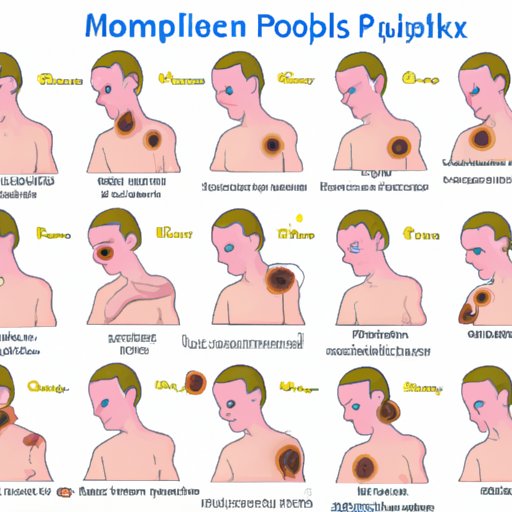Introduction
Monkeypox is a rare zoonotic virus that is closely related to the virus that causes smallpox. It is typically found in animals, but can be transmitted to humans, resulting in mild to severe flu-like symptoms and a rash that usually appears on the face, hands and feet. In this article, we will explore what monkeypox looks like on the skin, including its symptoms, stages and possible treatments.

Describing the Symptoms of Monkeypox in Detail
The early symptoms of monkeypox are similar to those of the flu, and may include fever, headache, muscle ache, exhaustion, and swollen lymph nodes. These symptoms can last for up to two weeks before the rash begins to appear. The rash is usually red or purple in color and consists of clusters of small bumps or lesions. These lesions typically start on the face and spread to other parts of the body, including the hands, feet, arms and legs.
Exploring the Different Stages of the Disease and How it Appears on the Skin
Monkeypox progresses through three distinct stages: papular, vesicular and pustular. During the papular stage, the rash appears as small, firm red bumps. As the disease progresses, the bumps become filled with fluid, forming vesicles, and eventually turn into pus-filled pustules. The rash may itch and can become quite painful. In some cases, the lesions can form scabs and scarring may occur.
The severity of the rash depends on the individual’s immune system and other factors. In some cases, the rash may be very mild, while in others it can be more severe and widespread. In addition, the rash may take on different appearances depending on the stage of the disease. For example, during the papular stage, the rash may appear as small red bumps, while at the vesicular stage, the bumps may become filled with fluid and look more like blisters.
Comparing Monkeypox to Smallpox: What’s the Difference?
Monkeypox and smallpox are both caused by viruses from the same family, but there are some important differences between the two diseases. While smallpox can be fatal in some cases, monkeypox is generally less severe and has a lower mortality rate. Additionally, the rash associated with monkeypox is typically less extensive than the one caused by smallpox.
Investigating Treatment Options for Patients with Monkeypox
Treatment for monkeypox is largely supportive. It is recommended that patients get plenty of rest and fluids, and take medications such as ibuprofen or acetaminophen to help reduce fever and pain. In some cases, antiviral medications may be prescribed to help reduce the severity of the symptoms and prevent complications. Additionally, topical creams may be used to help relieve itching and discomfort.

Examining How Monkeypox is Transmitted and Prevented
Monkeypox is typically spread through direct contact with an infected animal or person. It can also be spread through contact with objects that have been contaminated with the virus, such as bedding or clothing. To prevent infection, it is important to avoid contact with infected animals or people, and to practice good hygiene.

Analysing Potential Complications of the Disease and its Effects on the Skin
In some cases, monkeypox can cause serious health complications, such as pneumonia, encephalitis and even death. Additionally, the disease can cause long-term changes in the skin, such as scarring or discoloration. It is important to seek medical attention if you experience any of the symptoms of monkeypox, as early diagnosis and treatment can help reduce the severity of the disease and prevent complications.
Conclusion
Monkeypox is a rare zoonotic disease that can affect humans. It is characterised by flu-like symptoms and a rash that usually appears on the face, hands and feet. The rash progresses through three stages and can cause itching, pain and scarring. Treatment for monkeypox is mostly supportive, and includes rest, fluids and medications. It is important to seek medical attention if you experience any of the symptoms of monkeypox, as early diagnosis and treatment can help reduce the severity of the disease and prevent complications.


